Planning a trip to Japan? Here’s a handy guide or checklist to make sure you’re prepared. From where you require a Japan tourist visa to essentials you should pack, and finally a guide to how to reach the city from the airport. Here’s to hoping your trip gets off to a good start.
Table of Contents
- Japan Tourist Visa and Other Entry Requirements
- Preparing for Your Trip to Japan
- Japanese Public Transportation and Access to the City from Airport
- Takeaway
Chances are you’ve already decided on a trip to Japan if you’re reading this article. And can we say, excellent choice! There’s many things to do in Japan like admiring the beautiful scenery, dining on delicious food, experiencing new things, and most importantly immersing yourself in Japan’s unique culture.

To help you prepare for the trip, we’ve summed up what you need to know and prepare so your trip goes smoothly.
Japan Tourist Visa and Other Entry Requirements

Are you allowed to enter Japan? Some countries require a tourist visa to enter Japan, whilst some are exempted. Also, many countries have implemented traveller restrictions to prevent the spread of infectious diseases including Japan.
At the moment, visa-exemption into Japan is suspended. This means that every foreign traveller to Japan must apply for a short-term stay or tourist visa into Japan. Moreover, independent travellers are not allowed into Japan, only package tours are allowed. To visit Japan, you will need to find a tour company that organises trips to Japan who will apply for a tourist visa on your behalf through the ERFS (Entrants, Returnees Follow-up System) system. (This information is accurate as at September 8, 2022)
※ Ministry of Foreign Affairs of Japan, “Application for Visa for foreign nationals eligible for Phased Measures toward Resuming Cross-Border Travel”
Countries Exempted from Tourist Visa
(Resumed on October 11, 2022 - updated October 14, 2022)
Japan has made Visa Exemption Arrangements between 68 countries and regions. The visa exemption arrangement makes it convenient for residents of these countries/regions to visit Japan. With a valid passport, a tourist visa application becomes unnecessary and just filling out a customs card and submitting at the arrival airport is sufficient.
Depending on your country/region, your permitted period of stay may be different or additional conditions may be attached so make sure to check up on it beforehand. For example, Indonesia and Thailand passport holders can stay up to 15 days, whilst the majority of countries can stay up to 90 days. You are also not allowed to engage in activities for remuneration, in other words you cannot work.
List of 68 Countries and Regions for Visa Exemptions
Countries that Need to Apply for Japan Tourist Visa
If you are from any other country/region that does not have a visa exemption arrangement with Japan, you’ll need to apply for a tourist visa. The procedure is as follows:
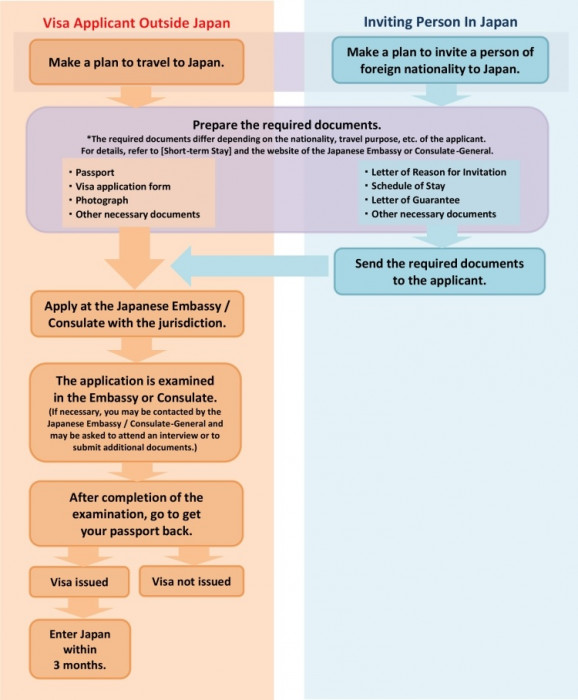
Image Credit: © Ministry of Foreign Affairs of Japan
Generally, the required documents are as follows:
-
Valid Passport
-
Visa Application Form
-
Photograph
-
Daily Travel Itinerary
Other documents may be required depending on your personal circumstances. For example travelling in a group, marital status, etc.
For more detailed information about Japan tourist visa:
Informative Guide for Tourist Visa Requirements in Japan
Coronavirus Measures in Japan
(New Measures started on October 11, 2022 - Updated October 14, 2022)

Japan opened its borders on October 11, 2022 and with it the loosening of previous border measures. The new measures as of October 11, 2022 are as follows:
- No more on-arrival testing and quarantine unless depicting symptoms like fever, etc.
- Certificate confirming 3 shots of COVID-19 vaccine complete required, or negative pre-departure test results for COVID-19 test taken within 72 hours of departure to Japan.
- Pre-arrival questionnaire required. Usage of "Fast Track" recommended.
In addition to that, the new standard of mask-wearing in Japan was recently announced by the Ministry of Health via Twitter as follows:
As a general rule, masks are not required outdoors, but recommended to be worn when talking to people from close range.
If you keep your distance from others indoors and do not talk much, then it is not necessary to wear [mask].
Please keep up with basic infection control measures, and wear/remove your mask in appropriate situations.
Resources to Check:
-
(MHLW) Coronavirus (COVID-19)
Writer's Pick
Preparing for Your Trip to Japan

Planning Your Japan Itinerary
Planning your itinerary is part of the fun when it comes to travelling. Here are some ideas of what to do in Japan:
-
A Trip to Japan’s Capital, Tokyo
-
Experiencing Japanese Nightlife
There’s also nothing wrong with winging your trip or following a hassle-free guided tour.
Things to Prepare Ahead of Time
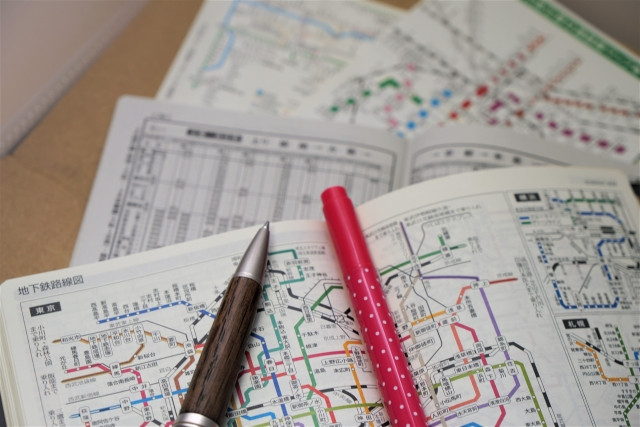
We’ll skip the standard preparation for trip tasks like getting plane tickets, choosing where to stay in Japan, booking accommodations, and applying for a visa (if necessary) which are things you obviously need to do. Instead, in this part, we’ll highlight to you things you didn’t know you should, or even could, prepare in advance.
-
Buying a Japan Rail Pass online or at a JR-designated overseas sales office/agency. Japan Rail Passes are more expensive when purchased in Japan. (Link)
-
Buying JR Passes online and collecting them after arrival in Japan.
-
Seat reservations for Shinkansen and limited express trains after buying Japan Rail Pass and JR Passes online means guaranteed seating even during peak seasons.
-
Buying tickets for amusement/theme parks, stage shows, events, festivals, etc. A recent change in Japan is that many places practise crowd control and reservations are required for entry, so no same-day ticket purchases.
-
Arranging for airport pickup SIM cards or pocket WiFis. This gives you the flexibility and time to choose the best deals rather than browsing through what’s available at your arrival airport and wasting time.
What to Pack to Make Your Trip Easier
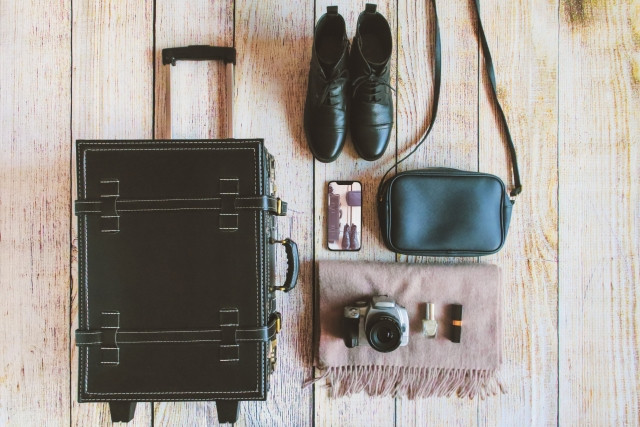
Japanese Yen
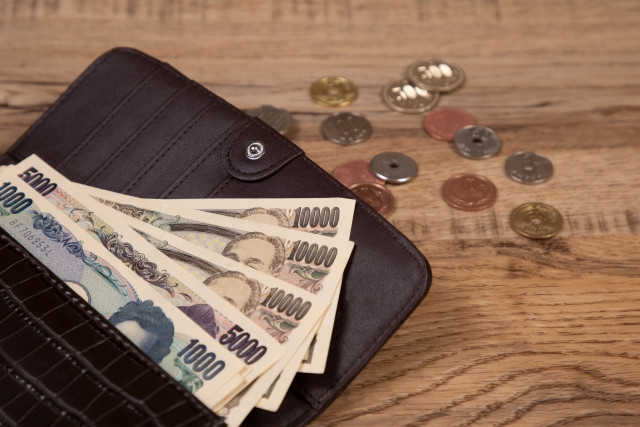
You can definitely get by in big cities like Tokyo and Osaka where credit card payments are widely available, but there’ll certainly be some places that only accept cash like most ramen restaurants. For countrysides and quieter areas, definitely have cash with you. Also, instead of waiting last minute to exchange currency, monitor the exchange rates and buy yen when rates are cheaper.
Travel Adapter

Japanese plugs may be different from your home country. Japan mostly uses type A sockets and plugs, whilst electricity runs at 100V and 50/60hz. For people coming from China, Canada and America, you should have no problem using your home country’s appliances. For other countries, bringing a travel adapter is highly recommended, especially for charging your devices. Be careful of the voltage differences too as incompatibility may damage your device. Hotels do provide adapters but subject to availability.
Season Appropriate Clothing

Japan experiences four seasons so temperatures can be very different depending on the time of year you visit. To add to that, seasons and climate across Japan can be very different which means north Japan experiences colder temperatures, whilst south Japan is warmer. In addition, snowfall and humidity that is affected by seasons between areas are also different. It is important to dress suitably for the seasons and do your research on the climate of your destination, or you will have a very uncomfortable trip and may even fall sick.
Spare Masks

Even before the Covid situation, Japanese people wear masks whenever they have a cold in consideration of others. And now, when it has become absolutely necessary, the majority (perhaps all) of people in Japan choose to wear masks even if they do not need to. Partly out of consideration for others, and also to protect themselves. Though it is no longer necessary to wear masks outdoors (unless crowded), many people still keep their masks on. In eating establishments, customers are requested to wear masks when not eating, and at many facilities, wearing masks is encouraged.
Read about Mask Use by the Ministry of Health. Covers a variety of situations where masks should be worn and occasions to go without a mask.
Also, read about Japan’s interesting relationship with masks in our article about Mask Culture.
Useful Apps to Install

-
Google Maps - Download Offline Map to save on data
-
Google Translate - Instant Camera Translation to translates signs and menus
-
JNTO - Japan Official Travel App for safety assistance, finding routes, and ideas for your trip
-
GuruNavi - Food Search
-
Happy Cow - Vegan Restaurant Finder, recommended for vegan travellers
-
Jorudan - Japan Transit Planner to look up your travel route including price breakdown and arrival departure times
-
PPPark (Japanese Only) - Parking Lot Search App, recommended if driving in Japan
-
Yahoo Weather (Japanese Only) - Most Accurate Weather App that has suitable weather clothing recommendations, heatstroke warning, strong wind alerts, bring umbrella advice, etc.
Public Transportation in Japan, and Access to Cities from Airports
In this part, we will introduce what you need to know about using public transportation in Japan. We will also cover in detail how to reach major cities Tokyo and Osaka from their nearest airports.
Transportation IC Cards
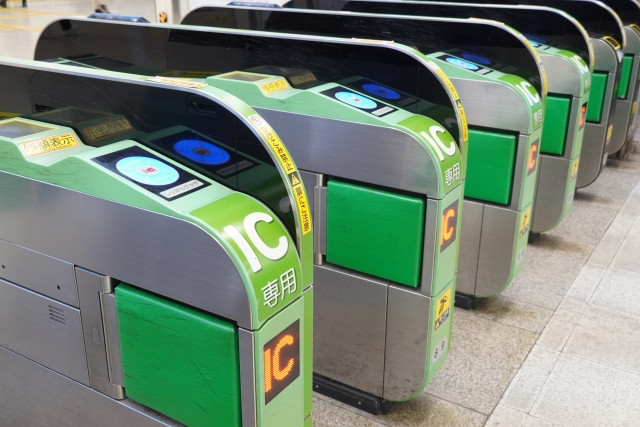
As a tourist in Japan, chances are public transportation is going to be your main mode of transportation around Japan. Not only is it cheaper, most major tourist areas and cities are best explored by public transportation which will bring you directly to tourist sightseeing spots.
So, what do you need to use public transportation in Japan? A Transportation IC card ( 交通系ICカード)! Yes, you can also use cash but it’ll be a hassle to dig through your purse and buy tickets each and every time, also it’ll cost a little more. Unless you’re a Japan Rail Pass holder, in which case you already have a transportation pass, but remember that’s limited for travel on JR services only. For anybody else, an IC card is the way to go. Keep in mind that less developed areas like the countryside may not have IC card compatible ticket gates (改札口 kaisatsu-guchi), you will have to purchase a physical ticket in those cases.
There are many different companies that offer IC Cards and most of them have nationwide compatibility. However, we recommend Suica by JR East or PASMO by Tokyo Metro that has smartphone compatibility. This means that you don’t need a physical Suica/PASMO card but can tap in/out with your phone once you add the card to your e-wallet, plus you can easily top-up your balance on your phone with your registered credit card at any time. Please check if your phone is compatible first. IC Cards are useable on both trains and buses.
[NOTE] Attention foreign Visa cardholders, since August 5, 2022, there has been an ongoing issue where Suica/PASMO cannot be charged with a foreign-issued Visa card. American Express, Mastercard and Japan-issued Visa cards can still be used.
※Impress Watch, "海外カードでSuicaのApple・Google Payチャージができなくなっている話"
Welcome Suica
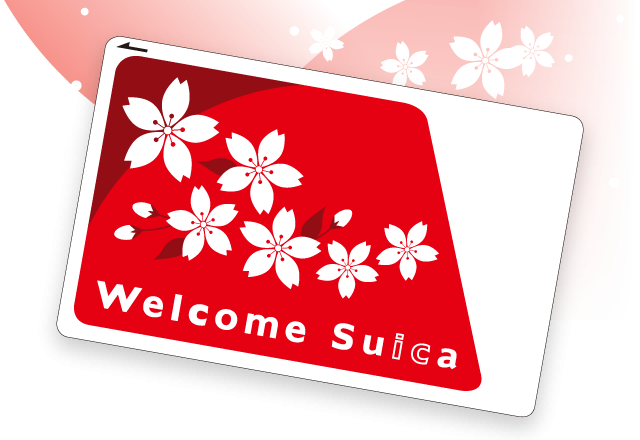
Image Credit: © JR East Japan Railway Company
The Welcome Suica is a transporation IC card targeted for foreign visitors to Japan. It works just like a regular IC card, but there are some differences:
- No deposit of 500 yen which is necessary for regular Suica card
- Valid for 28 days only from date of purchase
- Not reusable after expirition of validity period
- Discount tickets can be registered on the Welcome Suica
- Must carry reference paper (received when purchasing Welcome Suica and discount tickets) at all times
The Welcome Suica has a beautiful cherryblossom design. It makes for a lovely souvenir once you've finished your Japan trip.
Getting to the City from Airport
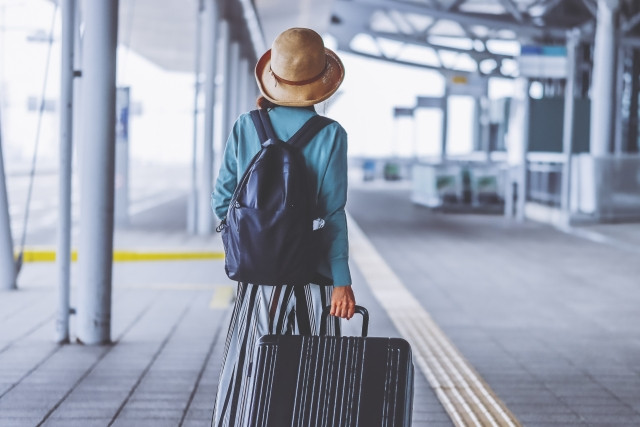
Tokyo - From Narita Airport & Haneda Airport

From Narita Airport
Narita Express Airport Shuttle is 1 of 2 fastest connections from Narita Airport to main cities in Tokyo. Stops along its route include Tokyo, Shinjuku, Shinagawa, Ikebukuro, and Shibuya Stations. Tokyo and Shinagawa Stations are where you can board the Shinkansen. Japan Rail Pass comes with unlimited usage for Narita Express, free seat reservations are also included.
Keisei Skyliner is the other fastest connection from Narita Airport to central Tokyo. Stops along its route include Ueno, Nippori and Aoto (some Skyliner trains) Stations. From Ueno Station, you can transfer to the local Hibiya or Ginza lines to reach main stations like Tokyo, Shinagawa, Ikebukuro, Shinjuku, and Shibuya Stations. When deciding between Narita Express and Keisei Skyliner, the ultimate decision-making points are whether you have a Japan Rail Pass (Keisei Skyliner not covered), and your destination (for Ueno take the Keisei Skyliner).
Narita Airport Limousine Bus are airport coach buses connecting you to major hotels and main cities in Tokyo. Stops along its route include Shinjuku, Ikebukuro, Akasaka, Shibuya, Shinagawa, and Yokohama. Previously there were many more stops along its route like Toranomon, Ginza, Roppongi, Akihabara and more, which have been suspended due to the Covid situation. Check their real time service updates for what stations are serviced. Keep in mind that the limousine bus service is not cheap but can be very convenient if your accommodation is nearby.
Airport Bus TYO-NRT is a budget bus that brings you between Tokyo and Narita Airport for a regular charge of only 1,300 yen (one-way daytime ticket). For late night and early morning routes, the price is doubled to 2,600 yen, but is still cheaper than the above options. Stops along its route include Tokyo, Ginza, Kajibashi Parking Lot (near Yurakucho Station), and Shinonome.
Keisei Narita Skyaccess is the cheapest train route between Tokyo to Narita Airport costing from 1,000 yen~2,000 yen. The exact price depends on your embarkation/disembarkation station aka distance travelled. The catch is that it takes a lot more time, around an hour, to reach your destination. Stops along this route include Oshiage (Skytree), Asakusa, Nihombashi, Ginza, Shimbashi and Shinagawa Stations.
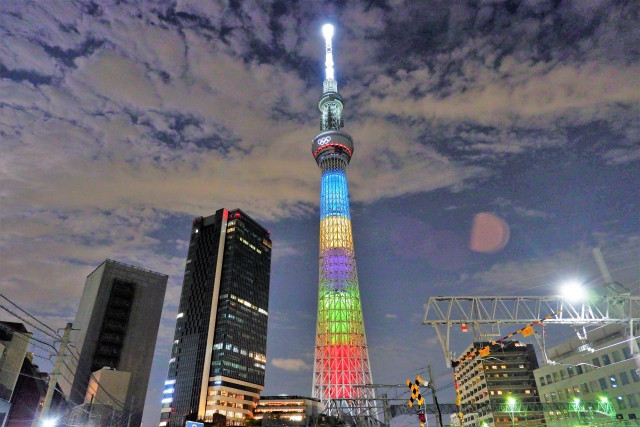
From Haneda Airport
Tokyo Monorail is a cheap and fun connection from Haneda Airport to Tokyo, specifically Hamamatsucho Station on the Yamanote Line. From there, you can easily navigate the Yamanote Line to reach various major areas in Tokyo including Shibuya, Harajuku, Shinjuku, Ueno, Yoyogi, Shinagawa, Shimbashi, Yurakucho. Keep in mind that the Yamanote Line is notorious for being super cramped which can be a difficult ride if you have a lot of luggage. In that case, we recommend arranging for luggage delivery to your hotel/accommodation. Usage of Tokyo Monorail is included in Japan Rail Pass.
Keikyu Line is the main train line for access between Haneda Airport, Tokyo and Kanagawa. Stops along this route include Shinagawa, Kawasaki, Yokohama, Kamioka, and Kanagawa. Haneda Airport is midway between the Keikyu Line that branches north towards Tokyo, and south towards Kanagawa. Be careful not to take the train that heads in the wrong direction. If there is no direct train, or it requires a long wait, to where you want to go, you can transfer at Keikyu-Kamata Station.
Haneda Airport Limousine Bus is operated by the same company that runs the Narita Airport Limousine Bus service. Stops along its route include Shinjuku, Ikebukuro and Tokyo Disneyland. Likewise, stops have also been suspended along its route so check their real time service updates for what stations are serviced (scroll down for Haneda).
Osaka - From Kansai International Airport
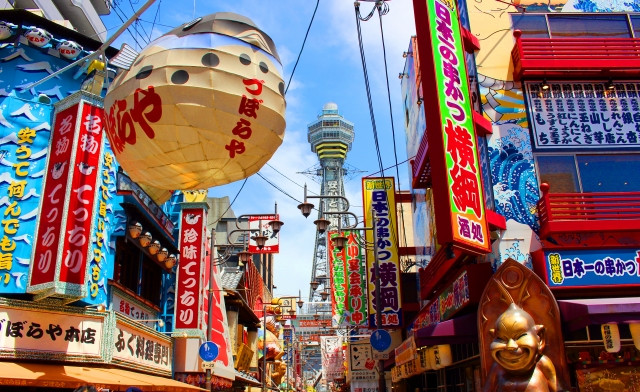
Limited Express Haruka is the fastest connection from Kansai International Airport to Osaka. 4 main stops along its route include Kansai Airport, Tennoji (35 minutes), Shin-Osaka (50 minutes) and Kyoto (1 hour 20 minutes) Stations. Recommended for fast and direct access to Kyoto. Limited Express Haruka is included in Japan Rail Pass.
Kansai Airport Rapid is the cheaper alternative to Limited Express Haruka. It makes more stops along its route, and may be more convenient depending on your destination. The 2 major stops along its route are Tennoji and Osaka Stations. Other stops along its route include JR Namba, Nishikujo (for Universal Studio Japan), and Kyobashi. Kansai Airport Rapid is included in Japan Rail Pass.
Nankai Airport Express is the cheapest connection from Kansai International Airport to the Namba area costing less than 1,000 yen. Stops along its route include Rinku Town, Kishiwada, Sakai, Tengachaya, and Shin-Imamiya. The route ends at Namba Station.
Limited Express Rapi:t is the faster and more expensive alternative to the Nankai Airport Express. It makes fewer stops than the Nankai Airport Express which is why it's faster, and all seats are reserved. There are two Rapi:t services that cover different routes but have the same final destination - Namba.
Takeaway

A trip to Japan makes for an unforgettable memory. Just because something goes wrong on your trip doesn’t mean it’s ruined, in fact it may serve to make it an even more memorable one. But still, no one wants trouble on their trip so the best thing you can do is prepare as well as you can, and we hope this article helps you achieve that.

.jpg)


















.jpg)

 (2).png)












